 from the BBC:
from the BBC:March 30, 2008
Synesthete says 'George Bush is like crusty potato'
 from the BBC:
from the BBC:March 28, 2008
539 layers in a comp

vfxhack.com posted a very large picture of a composition for a Timex ad with 539 elements (many themselves were comps of other hundreds of layers) in Insane Comp Scripts.
March 27, 2008
Video on Search Pages
"Google and Yahoo have both started including video advertising on search results pages. Depending on how consumers react, this could open a vast new source of ad revenue or could deter users from clicking on the already incredibly lucrative text ads."
Also, YouTube Reveals Video Analytics Tool for All Users, with a video from YouTube's Brand Channel:
Photoshop Express RIA arrives
 Go to John Nack to read all about the simple web version of Photoshop, free training and articles (picture from Terry White), and its improves terms of use.
Go to John Nack to read all about the simple web version of Photoshop, free training and articles (picture from Terry White), and its improves terms of use.
Hi-Def San Francisco
 This is sort of interesting, though really just a stock footage project:
This is sort of interesting, though really just a stock footage project:"Hi-Def San Francisco is project of CloudView Photography. The camera is a 3 megapixel StartDot Technologies Netcam XLmounted in a weather proof enclosure high in the hills of Sausalito. Images are captured every 15 seconds cropped from the full resolution to 1920x1080 and uploaded in 480, 720 and 1080 resolution to the web server. Periodically the software (running on a FreeBSD server) creates a time lapse that collapses the prior 24 hours into 240 seconds of video."
With malice toward none, with charity for all...
 After reading Robert Scheer and Gary Kamiya, I was reminded of the great Second Inaugural Address given by Abraham Lincoln on Saturday, March 4, 1865.
After reading Robert Scheer and Gary Kamiya, I was reminded of the great Second Inaugural Address given by Abraham Lincoln on Saturday, March 4, 1865.Fellow-Countrymen:
AT this second appearing to take the oath of the Presidential office there is less occasion for an extended address than there was at the first. Then a statement somewhat in detail of a course to be pursued seemed fitting and proper. Now, at the expiration of four years, during which public declarations have been constantly called forth on every point and phase of the great contest which still absorbs the attention and engrosses the energies of the nation, little that is new could be presented. The progress of our arms, upon which all else chiefly depends, is as well known to the public as to myself, and it is, I trust, reasonably satisfactory and encouraging to all. With high hope for the future, no prediction in regard to it is ventured
On the occasion corresponding to this four years ago all thoughts were anxiously directed to an impending civil war. All dreaded it, all sought to avert it. While the inaugural address was being delivered from this place, devoted altogether to saving the Union without war, urgent agents were in the city seeking to destroy it without war—seeking to dissolve the Union and divide effects by negotiation. Both parties deprecated war, but one of them would make war rather than let the nation survive, and the other would accept war rather than let it perish, and the war came.
One-eighth of the whole population were colored slaves, not distributed generally over the Union, but localized in the southern part of it. These slaves constituted a peculiar and powerful interest. All knew that this interest was somehow the cause of the war. To strengthen, perpetuate, and extend this interest was the object for which the insurgents would rend the Union even by war, while the Government claimed no right to do more than to restrict the territorial enlargement of it. Neither party expected for the war the magnitude or the duration which it has already attained. Neither anticipated that the cause of the conflict might cease with or even before the conflict itself should cease. Each looked for an easier triumph, and a result less fundamental and astounding. Both read the same Bible and pray to the same God, and each invokes His aid against the other. It may seem strange that any men should dare to ask a just God's assistance in wringing their bread from the sweat of other men's faces, but let us judge not, that we be not judged. The prayers of both could not be answered. That of neither has been answered fully. The Almighty has His own purposes. "Woe unto the world because of offenses; for it must needs be that offenses come, but woe to that man by whom the offense cometh." If we shall suppose that American slavery is one of those offenses which, in the providence of God, must needs come, but which, having continued through His appointed time, He now wills to remove, and that He gives to both North and South this terrible war as the woe due to those by whom the offense came, shall we discern therein any departure from those divine attributes which the believers in a living God always ascribe to Him? Fondly do we hope, fervently do we pray, that this mighty scourge of war may speedily pass away. Yet, if God wills that it continue until all the wealth piled by the bondsman's two hundred and fifty years of unrequited toil shall be sunk, and until every drop of blood drawn with the lash shall be paid by another drawn with the sword, as was said three thousand years ago, so still it must be said "the judgments of the Lord are true and righteous altogether."
With malice toward none, with charity for all, with firmness in the right as God gives us to see the right, let us strive on to finish the work we are in, to bind up the nation's wounds, to care for him who shall have borne the battle and for his widow and his orphan, to do all which may achieve and cherish a just and lasting peace among ourselves and with all nations.
March 25, 2008
Safari nets YouTube videos

"Use Safari [it works on Mac and Windows]. Open up the activity window in Safari, then load the YouTube page. You'll see the asset show up in the activity window, and it will be obvious because it's the only one that shows you streaming progress. Just double-click [or option double-click and rename the download] on the item in the activity window (you don't need to wait for it to finish streaming) and it should automatically download. You can do this with regular FLVs as well."
March 24, 2008
Mogul VFX platform
 Studio Daily is reporting that Imagineer Systems is making NAB announcements of a new VFX platform. The desktop solutions include:
Studio Daily is reporting that Imagineer Systems is making NAB announcements of a new VFX platform. The desktop solutions include:- mogul/roto is rotoscoping tool leveraging Imagineer's planar tracking technology
- mogul track is a desktop app for 2D and 3D tracking with support for third party software
- mogul/paint is a 3D vector based paint system based on mogul’s 3D engine
- mogul/comp is a node based compositing app for true 3D compositing with support of OpenFX plug-ins and Python scripting.
Update: FreshDV has some video from NAB 2008.
March 23, 2008
"Correct" skin tones
 Prolost continues with concentrated reads, now with the profusely illustrated Save Our Skins:
Prolost continues with concentrated reads, now with the profusely illustrated Save Our Skins:Update: HD Cinema has more on skin tones in Painting HD Cameras pt. 2 - Skin Tones.
March 22, 2008
Motion graphics 1961
Plus here's his brother James Whitney's Lapis from 1966:
And a recent oscilloscope composition by Robin Fox from Eyebeam's ReBlog:
If you like that, you might check out Oscilloclast, electromagnetic AV by Chris Musgrave.
March 21, 2008
Ease and Wizz, AE scripts for new easing types
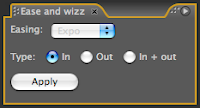 Ian Haigh announced Ease and Wizz, a donationware set of scripts for After Effects that gives you more ways to easily interpolate between values. The easing types include Expo, Circ, Quint, Quart, Quad, Sine, Back, Bounce, and Elastic; some are shown in a short video example and in an interactive visualizer. Ian explains:
Ian Haigh announced Ease and Wizz, a donationware set of scripts for After Effects that gives you more ways to easily interpolate between values. The easing types include Expo, Circ, Quint, Quart, Quad, Sine, Back, Bounce, and Elastic; some are shown in a short video example and in an interactive visualizer. Ian explains:"The obvious use is in motion, but they can be used on animated properties of any kind. They’re controlled with a After Effects-ish palette that can be docked, so it’s very easy to use. A while back, Flash guru Robert Penner created a suite of extremely useful easing equations that have been used to build thousands of websites worldwide. I've adapted these equations to work as expressions in After Effects."
Update: Alan Shisko adds, "There are two drawbacks to the script, both with workarounds. One, it only works on the first two KF's in an a given parameter. The workaround is to apply the script on multiple 'transform' EFFECTS instead of on to multiple keyframes on the 'transform' PARAMETER. And two, you can't view the resulting velocities in the Graph Editor (should you so choose) unless you select the KF's and go to Animation-> Keyframe Assistant-> Convert Expression to Keyframes. But I would surely recommend that you give it a try, I think you'll like it."
March 20, 2008
Free FEC 3D Relief plug-in for FCP and After Effects
 Via Flippant News and Creative Cow’s newsletter... a free FEC 3D Relief plug-in for FCP and After Effects. The previous temp offer for a Free Snow FxPlug filter is still in play for now.
Via Flippant News and Creative Cow’s newsletter... a free FEC 3D Relief plug-in for FCP and After Effects. The previous temp offer for a Free Snow FxPlug filter is still in play for now.
The Pentagon Goes Hollywood
 The Pentagon's relationship to Hollywood is hardly monolithic, although filmmakers who go native are often refused support, like Francis Coppola with his excellent Apocalypse Now.
The Pentagon's relationship to Hollywood is hardly monolithic, although filmmakers who go native are often refused support, like Francis Coppola with his excellent Apocalypse Now.Truthdig is hosting an interesting article on the conscription of popular imagination with The Pentagon Goes Hollywood by Nick Turse, author of The Complex: How the Military Invades Our Everyday Lives. The TomDispatch author interview is below.
Unfortunately, this excerpt article makes no mention of Jack Valenti and his infamous support for propaganda injection. Few of us remember which filmmakers volunteered to sprinkle their films with propaganda, even for recent projects after the September 11 attacks. For additional details see The Boston Globe series "Hollywood Goes to War," "Collateral Brain Damage? The Hollywood Propaganda Ministry" at Ratical, Operation Hollywood: How the Pentagon Shapes and Censors the Movies, and "The Manufacture of World Order: The Security Services and the Movie Industry" at Media/Culture Journal.
Smooth shakes in Final Cut
 On one e-mail list recently someone was looking to stabilize shaky footage just in Final Cut, and now Flippant News has a demo in Final Cut Pro 6, which has a "filter that analyzes the clip and makes the image smoother. You can find this filter under EFFECTS> Video Filters> Video> SmoothCam."
On one e-mail list recently someone was looking to stabilize shaky footage just in Final Cut, and now Flippant News has a demo in Final Cut Pro 6, which has a "filter that analyzes the clip and makes the image smoother. You can find this filter under EFFECTS> Video Filters> Video> SmoothCam."
March 19, 2008
SF Cutters on 27th with Wilt, editing, and filters
 SF Cutters' 8th Birthday Party is on Thursday, March 27th. The meeting is held at Adobe in San Francisco, so you have to pre-register. Scheduled guests include:
SF Cutters' 8th Birthday Party is on Thursday, March 27th. The meeting is held at Adobe in San Francisco, so you have to pre-register. Scheduled guests include:Digital video guru Adam Wilt will give a live demo on how to scan photos for Final Cut, a topic surrounded by much confusion (is video really 72 dpi, etc).
Mitchell Rose, comedy editor, instructor at CalArts, and stage performer will be showing his work and speaking about the aesthetics of editing, timing, and visual language.
Peter Litwinowicz, co-founder of ReVisionFX, will be showing DENoise, and other plug-ins.
New media and 5 years of war
 As General Petraeus indicates failure, Dick Cheney continues to conflate Iraq with September 11th attacks and John McCain is still very confused about the difference between Iran and Al-Qaeda. The noise machine continues its attempt to influence the media echo chamber with President Bush adding, "The battle in Iraq is noble, it is necessary, and it is just." In spite of this meme cluster, by now it should be clear that judgment -- not experience -- matters most.
As General Petraeus indicates failure, Dick Cheney continues to conflate Iraq with September 11th attacks and John McCain is still very confused about the difference between Iran and Al-Qaeda. The noise machine continues its attempt to influence the media echo chamber with President Bush adding, "The battle in Iraq is noble, it is necessary, and it is just." In spite of this meme cluster, by now it should be clear that judgment -- not experience -- matters most.As one might imagine, the aversion to fact and the real is reflected online too, with a varied playlist of clips found The YouTube Blog note The Iraq War, Five Years On. In another effort, Winter Soldier: Iraq and Afghanistan features audio and video testimony from U.S. veterans who served in those occupations. KPFA radio in Berkeley blogged and broadcast the event, with highlights repeated on Democracy Now.
Meanwhile the New York Times asks Can’t Grasp Credit Crisis? Join the Club, and this from the BBC, Tent City - America Style:
Adobe introduces its own DRM for Flash
 No matter Who Needs Flash on the iPhone More: Adobe or Apple?, Beet.TV leads with Adobe Introduces Digital Rights Management for Flash, and an interview below to ease you in.
No matter Who Needs Flash on the iPhone More: Adobe or Apple?, Beet.TV leads with Adobe Introduces Digital Rights Management for Flash, and an interview below to ease you in.Also, consider if you will EFF critical of Flash Video DRM and Look mum, no DRM: BBC launches iPlayer on iPhone and iPod touch.
Update: John Dowdell, Ryan Stewart, and Desiree Motamedi have some details on the Flash server DRM solution ($40,000 per CPU), which can encrypt FLV and H264 video content so that it only plays in Adobe Media Player (AIR integration built in), and manages on the server-side to restrict playback to rules set by the content owner.
Update 2: CNET reports Adobe realizes SDK not enough for Flash on iPhone,
Adobe clarified its CEO's comments in an official statement on Wednesday: "Adobe has evaluated the iPhone SDK and can now start to develop a way to bring Flash Player to the iPhone. However, to bring the full capabilities of Flash to the iPhone Web-browsing experience we do need to work with Apple beyond and above what is available through the SDK and the current license around it." Key words there: "beyond and above" (I always thought it was the other way around).
March 18, 2008
Digieffects Damage: AE filters
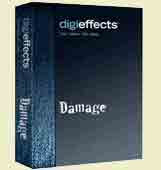 Toolfarm announced Damage, the latest After Effects filters from DigiEffects.
Toolfarm announced Damage, the latest After Effects filters from DigiEffects.Digieffects Damage consists of four plug-ins designed to create an extensive variety of digital and/or analog defects/errors in your footage. I didn't use Cinelook Film Damage, so I'm not sure if this is the next geneeration or something completely different.
Free Mac utilities for denoise, deinterlace, standards conversion
 I didn't know that when you export NTSC Quicktime file to PAL in Final Cut Pro it adds one black frame every 10 or so seconds on your file (not so with Compressor I suppose). That spurred Flippant News to note some possibly handy applications from Jan E. Schotsman, including:
I didn't know that when you export NTSC Quicktime file to PAL in Final Cut Pro it adds one black frame every 10 or so seconds on your file (not so with Compressor I suppose). That spurred Flippant News to note some possibly handy applications from Jan E. Schotsman, including: 1) Deinterlancer, which deinterlances movies, changes field dominance/order, converts PAL to NTSC or Custom, and more; and 2) Video Cleaner, which removes noise, logos, and cross-luma.
March 17, 2008
SFMograph on Thursday, but you must pre-register!
 The SFMograph meeting is on Thursday March 20th at Adobe in San Francisco, but you must pre-register!
The SFMograph meeting is on Thursday March 20th at Adobe in San Francisco, but you must pre-register!Presentations are planned by David Simons & Dan Wilk (the original creators of CoSA After Effects, now on the Dynamic Media Advanced Product Development team at Adobe), Chris Prosser (After Effects Engineering Manager), Brendan Bolles, Marcello Grande, and Matt Silverman.
Convert QT <-> AVI without recompression
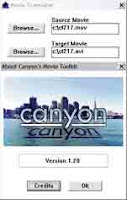 TRMOOV is an old Windows application for converting back and forth between the QuickTime and the Video for Windows (AVI) file format without recompression (via Phil Spitler). It's connected to the original developers of QT for Windows (backstory 1, 2).
TRMOOV is an old Windows application for converting back and forth between the QuickTime and the Video for Windows (AVI) file format without recompression (via Phil Spitler). It's connected to the original developers of QT for Windows (backstory 1, 2).The source and target codecs must be present on both platforms (for example, DV or Cinepak) and sampling rates should be the same. File names have to be 8 characters (or less) with 3 more for the file extension.
Caveats are at Download Recordings, and Bob Currier of Synthetic Aperture discusses TRMOOV in Converting Between QuickTime and AVI, but I still have a question.
Does PremierePro CS3 on Windows have to conform an AVI DV file made from a QT DV file? Here's a sample AVI rewrap if you can test it in Premiere...
Update: I have a reliable report that the rewrapped AVI from MOV doesn't import into Premiere, though it does import into AE.
Microsoft licenses Adobe’s Flash Lite
 Kinda funny after Steve Jobs' comments, Microsoft licenses Adobe’s Flash Lite. see ZDNet's The motives in a nutshell, and TechCrunch. Here's an interview from Beet.TV's Strange Bedfellows: Microsoft's Silverlight to Stream On Adobe's Flash Light 3:
Kinda funny after Steve Jobs' comments, Microsoft licenses Adobe’s Flash Lite. see ZDNet's The motives in a nutshell, and TechCrunch. Here's an interview from Beet.TV's Strange Bedfellows: Microsoft's Silverlight to Stream On Adobe's Flash Light 3:Also, from Beet.TV a recent demo, Flash Player Debuts on U.S. Mobile Phones:
Update: Beet.TV added another part of the same interview, where Brian Frank "explains how Flash became ubiquitous on mobile phones in Japan starting five years ago:"
March 15, 2008
YouTube quality bump
 YouTube responds to Hulu with YouTube Everywhere, live video, and TiVo, but also with higher quality video according to the YT blog; see YouTube Videos in High Quality. A low quality version is also transcoded and made available to the low end, and a preference is available on the user's account.
YouTube responds to Hulu with YouTube Everywhere, live video, and TiVo, but also with higher quality video according to the YT blog; see YouTube Videos in High Quality. A low quality version is also transcoded and made available to the low end, and a preference is available on the user's account.The new spec is 480x360, up to 900 kbit/s A+V (1 GB upload size limit), but getting stereo hasn't been a sure thing. Various players think the hi-qual clips are h.263 or FLV only as well as h.264, and some of them at least won't play in QuickTime Player when relabeled as .mp4.
Wired has a handy summary of some of the work done by YouTubers who watched the transition for the last few months.
In the old system, it seems you could get stereo if you submitted a movie (FLV or other) with a lower data rate than their threshold for resampling, which is 350 kbps. According to a thread on Video Help, "if you use mencoder, this code is simply amazing for stereo audio, and often gives you a lower average than 96 kbit/s (what they use now):
-oac mp3lame -lameopts vbr=2:q=8:aq=0:mode=1:padding=2:lowpassfreq=16300 -channels 2 -srate 44100"
RED ONE introductions
 The RED ONE is finally a reality and popular for a high-end camera, so workflow information is starting to filter out for those not in the early adopter set like those on REDuser.net. If you've been avoiding the hype, fxguidetv has started a two-part series on the RED camera workflow in post. There's also introductory looks at RED Cine and the camera itself at WonderHowTo.
The RED ONE is finally a reality and popular for a high-end camera, so workflow information is starting to filter out for those not in the early adopter set like those on REDuser.net. If you've been avoiding the hype, fxguidetv has started a two-part series on the RED camera workflow in post. There's also introductory looks at RED Cine and the camera itself at WonderHowTo.DV and Indie4K are posting approachable items. The Edit Blog is posting stories, and is especially concerned with conforming an offline edit into an online edit for finishing; Scott Simmons also posts at Studio Daily and notes The Great Red Hype from an Avid list. Prolost goes deep in several articles and gives you settings to match the RED Log transfer function using Cineon log/lin tools in common compositing applications.
Update: Adam Wilt engages in "an unfair comparison of three entirely different cameras" in Three three-letter cameras: EX1, F23, RED.
Update 2: More links from the AE-list (which isn't so impressed with the software), Hi Def Expo movies (also in iTunes) and The Editors' Lounge How to Post with the RED ONE™ Camera! (with PDF booklet).
Update 3: The Edit Blog mentions a new app, Crimson takes a stab at a real RED conform. Plus, HD for Indies is back with a variety of RED notices.
Update 4: Adam Wilt, Art Adams, Frank Capria, and other offer regular advice at PVC.
Update 5: The Edit Blog notes and adds commentary in fxguide tv posts episodes on RED.
Update 6: Self-Reliant Film has a log list of links to various RED resources. FxGuide likes RED so much it started a separate podcast series.
Tools for Visualization
 ReadWriteWeb has a survey on The Best Tools for Visualization by Sarah Perez:
ReadWriteWeb has a survey on The Best Tools for Visualization by Sarah Perez:"Visualization is a technique to graphically represent sets of data. When data is large or abstract, There are visualization tools for search, music, networks, online communities, and almost anything else you can think of. Whether you want a desktop application or a web-based tool, there are many specific tools are available on the web that let you visualize all kinds of data."Read the rest at ReadWriteWeb. Reliable sources on infographics and visualization can be found at information aesthetics and John Nack on Adobe.
March 14, 2008
Food Fight
HDMI cable differences
 From Discrete Cosine: "The CBC did a nice little [video] piece on the scam of high priced HDMI cables."
From Discrete Cosine: "The CBC did a nice little [video] piece on the scam of high priced HDMI cables."Bottom line: with a picture quality analyzer, a pro can't find differences in signal quality between $12, $110, and $262 HDMI cables. Comments on the piece offered explanations.
Hullfish on secondary color correction
 The Art and Technique of Digital Color Correction by Steve Hullfish, a hands-on companion/redo of an earlier book, was released recently. Below is Steve 's explanation of secondary color correction using Apple Color done for the Avid-L2 list and posted on the Colorlist; a small QT version is on The Moving Pictures Collective. (via Prolost)
The Art and Technique of Digital Color Correction by Steve Hullfish, a hands-on companion/redo of an earlier book, was released recently. Below is Steve 's explanation of secondary color correction using Apple Color done for the Avid-L2 list and posted on the Colorlist; a small QT version is on The Moving Pictures Collective. (via Prolost)More colorist stuff can be found at the Fini blog, [update] which now says Color 1.0.2 is broken.
Paths to Shapes
 If you paste some illustrator paths into an After Effects Shape layer and the paths are pasted as masks, you need to look at Trish Meyer's essential trick to paste multiple paths to After Effects Shape Layers at once: Pasting Paths from Illustrator to After Effects.
If you paste some illustrator paths into an After Effects Shape layer and the paths are pasted as masks, you need to look at Trish Meyer's essential trick to paste multiple paths to After Effects Shape Layers at once: Pasting Paths from Illustrator to After Effects.For background, see Shape Layers in After Effects CS3 by Total Training host Steve Holmes at Layers magazine
Update: Motionworks has a 2007 tutorial movie also, Mask to Shape Layer, and Aharon Rabinowitz added a podacst An Introduction to Shape Layers.
March 13, 2008
AE Script Demo palette in Chad and Todd Podcast
 Chad and Todd Perkins have a podcast series sorta called All Things Adobe, which covers Flash, AE, and other Adobe tools. Topics have included the secret library of free 3D models that ships with Photoshop CS3 and the hidden Script Demo "palette" in After Effects.
Chad and Todd Perkins have a podcast series sorta called All Things Adobe, which covers Flash, AE, and other Adobe tools. Topics have included the secret library of free 3D models that ships with Photoshop CS3 and the hidden Script Demo "palette" in After Effects.They also do Flash/Flex/web scripting and Production Premium training for Lynda.com.
Hulu embed 'The Tick'
March 12, 2008
If the rain comes
Racist politcal scheming and phony claims that cause war however could use some fair-minded clarification that help train the mind for your day of days.
We control the vertical
As the bridge between television and the internet expands, here's Broadcast Standards by Casimir Nozkowski, which uses public domain footage and stills to promote a contest run by The Independent Film Channel. IFC is looking for pilots and trailers for a new web series. (via The Edit Blog)
The owners of the pipes think they own everything, but rentals and squatting work too in this world of castles made of sand.
March 11, 2008
Can you pass the Awareness Test?
 Norman Hollyn posted a link to an awareness test, because "In editing, we’re constantly making decisions to focus our audience’s attention." Don't peak at his full post until you've looked at the (harmless) awareness test video.
Norman Hollyn posted a link to an awareness test, because "In editing, we’re constantly making decisions to focus our audience’s attention." Don't peak at his full post until you've looked at the (harmless) awareness test video.
Introducing Color Management in AE
 Be the first on your block to use "PWS" casually!
Be the first on your block to use "PWS" casually!Trish & Chris Meyer write "Tips N Tricks" articles for Artbeats.com, which will updated you monthly if you get the newsletter (plus you get Artbeats DV stock samples). This month Trish & Chris is introducing Color Management in After Effects CS3 (PDF), which covers input, output, monitoring, and the Project Working Space.
March 10, 2008
Pushing Flash H.264 to the limit
 Fabio Sonnati of Flash Video Factory posted several notes and some demos of his tweaks for Flash H.264 on his blog, Flash Video Optimization and Tools. He got great results on the 720p High Definition (1280x720x25Fps) plus HE AACv2 audio @ 500Kbit/s (for full-screen, double click on the movie) and for the YouTube size at 124 Kbit/s. YouTube encodes at around 350 for its lo-res version.
Fabio Sonnati of Flash Video Factory posted several notes and some demos of his tweaks for Flash H.264 on his blog, Flash Video Optimization and Tools. He got great results on the 720p High Definition (1280x720x25Fps) plus HE AACv2 audio @ 500Kbit/s (for full-screen, double click on the movie) and for the YouTube size at 124 Kbit/s. YouTube encodes at around 350 for its lo-res version.Fabio is using a mix of (parameters that hopefully CS4 will have) "Ffmpeg, x264, Mencoder and Nero AAC. Here some parameters used: 5 reference frames, 5 B-frames, authomatic B-Frames, B-pyramid enabled, adaptive macroblock type, advanced Trellis on, Subq=7, advanced exagon search, deblocking filter with custom alpha e beta parameter, three pass encoding...".
Update: Adobe has an HD Gallery to showcase other work, and CamcorderInfo posted Round-up: Watch HD video. Sorry, but "Operation MySpace" leaves a bad taste.
Don't forget this issue according to Adobe: "One important thing about playing an H.264 video file as progressive download is that the moov atom needs to be located at the beginning of the file, or else the entire file will have to be downloaded before it begins playing." You can fix this with QTIndexSwapper (an Adobe AIR app by Renaun Erickson).
...Later Fabio presented at Adobe Max 2009,
Social networks for free
The SxSW 2008 Insider's Guide was built with Ning, an online service where you can create, customize, and share your own social network for free. Ning staff includes Marc Andreessen (of Mosaic/Netscape fame) who explained some of the technology and partners behind Ning in articles (1, 2) and posted the video below. Ning already has a challenger in KickApps, which aims to appeal more to organizations.
Ning uses OpenSocial by Google, which "provides a common set of APIs for social applications across multiple websites. With standard JavaScript and HTML, developers can create apps that access a social network's friends and update feeds."
Online video ads made easy

Jivox online video advertising is a new company that helps businesses make and distribute web video ads without professional help (shh!):
"tell customers about your business beyond the visual and geographic limitations of search engines and banners. With Jivox, you can easily create free professional video advertisements for your business with music, visuals, and more. Through the exclusive Jivox network your ad will appear 'on the digital air.' Jivox pinpoints the sites your customers go to in the markets you need to reach them. You only pay for the actual sites where your video ad runs."They have an ad gallery to show what it can do now, except for the hard part -- actual targeting network and ad campaign management. (via)
March 8, 2008
South by Southwest coverage
 South by Southwest (SXSW) is starting and offering video coverage and interviews. Hopefully some of the more interesting talks will be available soon, like Animation and Digital Effects on a Budget with Scott Kirsner, Mark Forker, Alex Lindsay, Stu Maschwitz, and Geoff Marslett.
South by Southwest (SXSW) is starting and offering video coverage and interviews. Hopefully some of the more interesting talks will be available soon, like Animation and Digital Effects on a Budget with Scott Kirsner, Mark Forker, Alex Lindsay, Stu Maschwitz, and Geoff Marslett.Update: Some videos from SXSW available through Mahalo, Google search and SXSW Videos.
SXSW Interactive is one of the largest tech industry events of the year; here's a Mahalo Daily report from the show floor as they look for the next “killer app” at the SocialThing and Kyte (connects web & mobile video, see TechCrunch video) booths:
Update: and among several from Beet.TV, Mobile Video Blogging is Big with Power Bloggers
Flash CS4: IK, curve editor, 3D postcards, XML
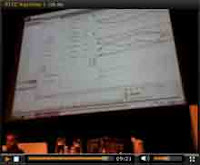 A few weeks ago, Adobe demonstrated a bunch of new features in Flash CS4 ("Diesel"), including inverse kinematics, animation curves and a new tweening model, 3D "postcards in space," advanced text, and encrypted video streams. Aran Balkin posted a video of the demo in Astro and Diesel sneak peeks at FITC Amsterdam - Updated.
A few weeks ago, Adobe demonstrated a bunch of new features in Flash CS4 ("Diesel"), including inverse kinematics, animation curves and a new tweening model, 3D "postcards in space," advanced text, and encrypted video streams. Aran Balkin posted a video of the demo in Astro and Diesel sneak peeks at FITC Amsterdam - Updated.Also, the Moockblog and Peter Elst have reported that Flash CS4 will be able to export and import a new source format based on XML called XFL:
"An XFL file is a .zip file that contains the source material for a Flash document. Within the .zip file resides an XML file describing the structure of the document and a folder with the document's assets (graphics, sounds, etc). The exact details of the XFL format are not yet available, but Richard assures me that Adobe intends to document them publicly, allowing third-party tools to import and export XFL." (via)
John Nack also noted various instances, including video, of sneak peaks of InDesign CS4's new Flash export features.
March 7, 2008
Behind the scenes on BBC workflow to web & mobile
 The BBC blogged a bit about their workflow to the web and mobile devices in BBC iPlayer On iPhone: Behind The Scenes:
The BBC blogged a bit about their workflow to the web and mobile devices in BBC iPlayer On iPhone: Behind The Scenes:"...every programme needs to be transcoded in a Flash version (for PC streaming), a WMV version (Windows PC download), MPEG2 (TV set-top box), H.264 (web browser), and a variety of other formats coming soon. To do this, we have a transcoding farm of over 50 rack-mount PCs, most of which are running really fast dual quad-core Xeon CPUs. As content arrives off tape (for pre-recorded programmes) or off-air (from our digital satellite links, for live content like news and sport), it's fed into the transcoding platform.Update: backgrounder from Last100 -- Look mum, no DRM: BBC launches iPlayer on iPhone and iPod touch.Those input files are encoded at over 50Mbps which makes them huge - around 25GB per hour of incoming video. With eight BBC TV channels plus 18 regional news broadcasts, that means we need to deal with up to 24 simultaneous incoming programmes, for a peak data rate of over a gigabit per second of incoming video." (via)
March 6, 2008
iPhone pans Flash to make platform play
 Many are raving over the iPhone SDK and the big bag of money for development, and often don't even mention that Flash isn't part of the deal. But what is the deal really and how much influence will mobile devices have over the Internets and Rich Media Applications?
Many are raving over the iPhone SDK and the big bag of money for development, and often don't even mention that Flash isn't part of the deal. But what is the deal really and how much influence will mobile devices have over the Internets and Rich Media Applications?AppleInsider attempted to justify answers on Flash that were panned in comments, but the sneaky CounterNotions may have anticipated the apparent (QuickTime, HTML, WebKit, JavaScript, CoreImage, Cocoa Touch) platform play, to borrow the Ryan Stewart phrase he typed from the Silverlight conference.
37 Signals is thinking phone but the observation applies more generally:
"Apple has the superior product, the big momentum, the cool, the lust, the business hooks, the consumer hooks, the customer experience, the interface, the design (interface and industrial), the smooth development environment, the vision.Update: Frank Capria looks at Emerging Mobile Trends (Mobile video’s not hit the mainstream… yet).And, maybe the secret key to it all, they have the commercial platform that makes it possible for a developer to actually sell, distribute, and update their software with the flip of a switch. And don’t forget the customer experience revolution — buying and it-just-works installation of iPhone software will be as one-click easy as buying music from the iTunes store. It’s all wrapped into one beautiful package. A package that only Apple can deliver."
Update 2: Adobe says Flash is coming to the iPhone.
March 5, 2008
Book video, part of rise of video retailing
 Using video to publicize books has gone beyond the digital media training world of Peachpit -- with Amazon (also with video reviews) and Borders now supporting video, the rise of book video hubs like Bookwrap Central and BookVideos.tv, and support resources for authors like Treated & Released.
Using video to publicize books has gone beyond the digital media training world of Peachpit -- with Amazon (also with video reviews) and Borders now supporting video, the rise of book video hubs like Bookwrap Central and BookVideos.tv, and support resources for authors like Treated & Released.Here's hoping that Barns & Noble Studio will somehow push B&N to carry better books:
Barns & Noble plans to launch a multimedia network on its website Monday reports USA Today, with two video programs and more than 700 other book-related videos, organized by genre and including author interviews and book readings....read the rest at WatchingTV Online, and more on video in retail at USA Today...
It's the latest salvo in what Internet Retailer editor Kurt Peters calls an "online video revolution" in retail. Websites use video to give shoppers new ways to interact with products and, of course, to boost sales.
Update: On Sep 17, 2008 Camcorder.info posted Every Book Needs a YouTube Trailer.
Enable Legacy Codecs in QuickTime
from Creative Workflow Hacks:
"Lost your Quicktime export options?If you updated to the latest version of Quicktime you lost some of your export options like Sorenson (You take the good with the bad with the beneficent dictatorship that is Apple UI design)."
To restore them, check Show Legacy Encoders in QuickTime preferences. One way is in QT Player> Edit> Preferences> Advanced.
Tracking and Replacing tutorials
 Harry Frank has a tracking and roto tutorial (among many others) at his Graymachine website -- "this one was a particular challenge: replacing a spinning record label with an overlapping hand. This covers tracking, rotoscoping, and various types of manual animation to match the movement in the shot."
Harry Frank has a tracking and roto tutorial (among many others) at his Graymachine website -- "this one was a particular challenge: replacing a spinning record label with an overlapping hand. This covers tracking, rotoscoping, and various types of manual animation to match the movement in the shot."Also, Imagineer Systems has tutorials for their tracking and roto apps including Mocha/AE (see comparison movie), as well as great deals for freelancers. The deal was extended and is active until 03/31/08; the freelancer code is "edu-mar08-90-imagineer" (no paren).
Field order & video misconceptions
 Trish & Chris Meyer are posting their library of tutorials on After Effects and video onto their ProVideo Coalition blogs: Creating Motion Graphics and CMG Keyframes. The latest ones debunk common misconceptions on field dominance, field rendering, and time code; others clarify luminance, float, aspect ratios, and more.
Trish & Chris Meyer are posting their library of tutorials on After Effects and video onto their ProVideo Coalition blogs: Creating Motion Graphics and CMG Keyframes. The latest ones debunk common misconceptions on field dominance, field rendering, and time code; others clarify luminance, float, aspect ratios, and more.Plus there's Favorite Technical References if you want extra geek.
They also have a video/DVD explaining all this quite effectively: VideoSyncrasies, The Motion Graphics Problem Solver.
Videocopilot demo of Twitch filter

Videocopilot has a demo movie of Twitch, their new plug-in for After Effects. Look for a ton of tutorials to show you every feature.
Steve Jobs, love him or hate him, is Arab-American
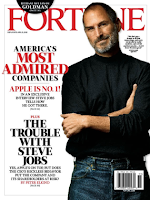 ...and maybe Jewish too, depending on your reality-distortion field. TechCrunch claims that Love Him or Hate Him, Fortune Cannot Make Up Its Mind About Steve Jobs.
...and maybe Jewish too, depending on your reality-distortion field. TechCrunch claims that Love Him or Hate Him, Fortune Cannot Make Up Its Mind About Steve Jobs.I don't read Fortune magazine but I did find it interesting that I missed the news that Jobs' biological father was a Syrian Arab, who lives not too far from Cupertino. His biological mother is Joanne Carole Schieble from Wisconsin, who some think is Jewish (not that there is anything wrong with that). More articles says that his mother is German/Swiss Catholic. Some background can be found in an article from the Green Bay Press Gazette, which was re-posted in Silicon Valley Watcher.
Update: also fun is that Jobs' biological sister Mona Simpson was the inspiration for naming Homer Simpson's mother, by her boyfriend Jeff Appel who was a writer on The Simpsons.
Update: more details leaked out after Jobs' death in 2011. See especially Macworld UK's 2015 article, Who is Steve Jobs’ Syrian immigrant father, Abdul Fattah Jandali?




